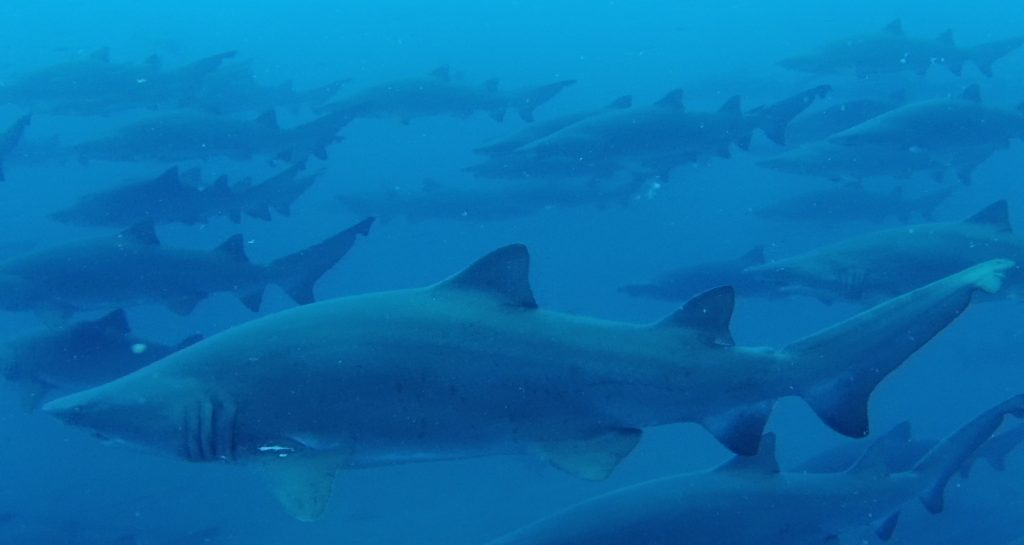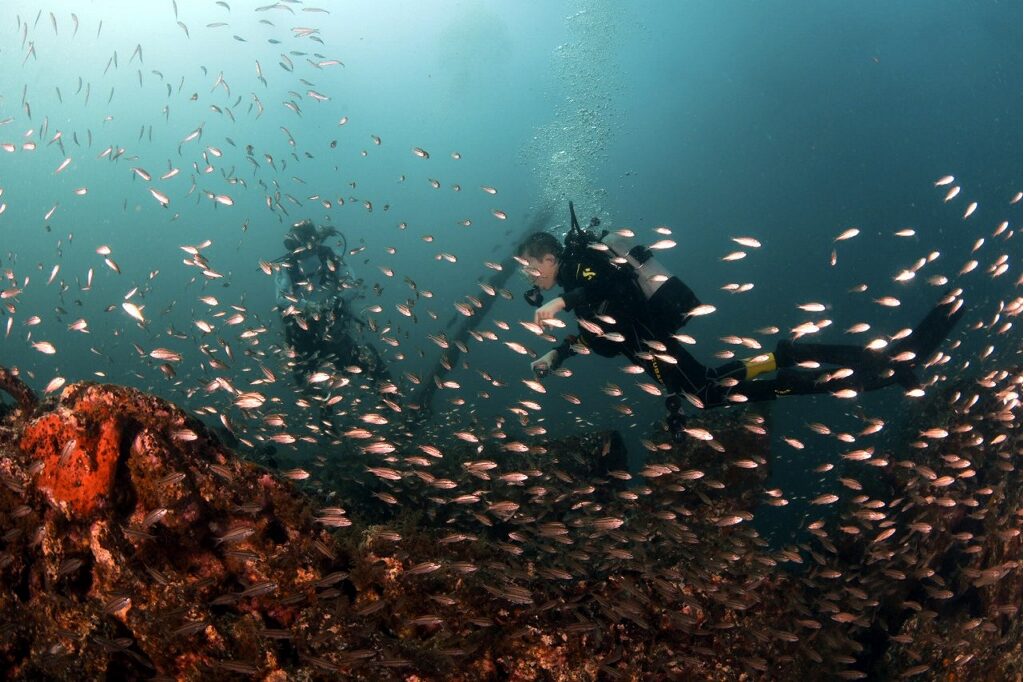
“Sand Tigers” by Todd Gardner
I love Shark Week. Not for the shows. They are mostly terrible, and I can’t watch them. I love it because it gets people thinking and talking about sharks. Although I was brought up in the age of Jaws (My dad took me to see it in the theater and I was creeped out in the water for several summers), I also knew there was something special about sharks from a very early age. Shark week was introduced by the Discovery Channel in 1988 and was purportedly devoted to conservation efforts and clearing up misconceptions, but it soon devolved into junk science, misrepresentation of real science, outrageous dramatization, and even blatant fiction. Such is the nature of TV and ratings. Sometimes I forget that even the show that fueled my passion for marine life as a child: The Undersea World of Jacques Cousteau, was not immune to hyping up the danger of sharks. The last time I watched an entire shark documentary on the discovery channel was more than 20 years ago. It was at the home of a professor who had invited his grad students over to drink beer and laugh at the absurdity of the reporting. It’s sad to think of all the missed opportunities for education when they take years’ worth of underwater footage and pair it with suspenseful music and misinformation.
In our house, much of our life revolves around marine life (we have a room devoted to aquaria, we breed fish for The Biota Group, and we dive regularly), however my son has never watched a discovery channel shark documentary and he had never heard of shark week until yesterday. I had to explain it to him on the dive boat, on our way out to celebrate our own version of shark week. We arrived at the dock in Swansboro to meet up with the crew of Instigator Fishing and Diving Charters run by our friends Cindy Norris and Ryan Borowicz. These two have a gift when it comes to getting you to the most amazing places. We were super lucky to be joined on the boat by world famous shark photographer Tanya Griffin Houpermans, as well as Carol Seals Price, the Conservation Research Coordinator for the North Carolina Aquariums. We headed out of bogue inlet and cruised for 2 ½ hours to reach the wreck of the Caribsea, a 251-foot US freighter that was sunk by a torpedo strike by U-158 in the WWII Battle of the Atlantic. It is resting in 90 feet of water, about 15 miles northeast of Cape Lookout. The shipwrecks off the coast of North Carolina are famous for their diversity of tropical and subtropical marine life, but a few, including the Caribsea, attract large aggregations of sand tiger sharks, and that’s what we were there to see.
On the way out, Finn confided that he was a little nervous. He had been in the water with sharks before, but never so many. And this was going to be his deepest dive to date and his first dive on Nitrox. It was also the longest boat ride of his life so far. As we approached the wreck site, we saw that there was another dive boat already there. It was the Olympus from our other favorite Dive shop, Olympus Divers in Morehead City. Once Captain Ryan of the Instigator got us perfectly positioned over the stern of the Caribsea, his mate got us tied in and we suited up and got in. Finn and I started our descent down the anchor line and within seconds, we were surrounded by sand tiger sharks. I’ll never forget how it made me feel to watch all my son’s fears melt away as the beauty and awe of our situation took hold of him. My heart felt like it might explode, not from the pressure 80 feet under the surface, but from the joy of sharing this moment with these magnificent creatures. Each one a living, breathing soul, going about its day, doing its best to get by in this world, just like us, and I could see that Finn felt it too. It’s a moment I will never forget.
After taking in the scene, Finn remembered his new GoPro and began fearlessly positioning himself to get photos and videos of the sharks. A few minutes later, we decided to venture off towards the bow of the wreck. We encountered another diver there. Not someone from our boat, but from the Olympus. Despite all our gear, we recognized each other. It was our friend Bobby Purifoy from Olympus Divers. He was taking photos and he snapped a few shots of Finn and me as we swam by. I live in a small town, so I’m accustomed to running into familiar faces in the supermarket, but this takes small town life to the next level. We finished our dive and couldn’t get back in the water fast enough. We had one hour surface intervals between dives, so Finn and I passed the time by freediving while we waited for our blood to degas. On a single breath we were able to get down around 50 feet, passing through thousands of spadefish and down to the sharks. Back on the boat, we planned our successive dives. Finn told me he’d like to spend more time on the engine and boilers because they were so full of life, and he was enjoying looking at the small stuff just as much as the sharks. The day just kept getting better. On the way home, between naps and watching flying fish, Finn told me at least a dozen times that it was the best day of his life. This is our Shark Week!

“Finn and Todd Gardner in the Caribsea” by Robert Purifoy
In the spirit of Shark week, here are a few fun facts:
1. Female sharks have two functional uteri where pups or egg cases (depending on the species) develop. Sand tigers exhibit a unique fetal behavior termed adelphophagy, which means sibling eating. Multiple embryos begin developing in each uterus, but the first one to finish its own yolk sac will then eat it’s siblings and any other yolk sacs the mother produces in order maximize its growth and development before birth. Only one pup ends up emerging from each uterus in a given reproductive event.
2. Although sharks are considered fishes, they are actually more closely related to you and I than they are to hagfish and lampreys, which are also considered fishes. This seems strange, but only if you’re still using the vertebrate family tree you learned in fourth grade. We were taught that the major groups of vertebrates are fishes, amphibians, reptiles, birds, and mammals. This is confusing because amphibians, reptiles, birds, and mammals each represent a distinct vertebrate class, while the things we call fishes are represented by five different vertebrate classes that all happen to live in the water and have superficial similarities. Comparing a shark to a tuna is like comparing a human to lizard. They are in two different taxonomic classes.
3. You probably know that members of class Chondrichthyes (Sharks, rays, and ratfishes) have skeletons of cartilage rather than bone, but did you ever think about how they make red blood cells since cartilage isn’t permeated by blood vessels and contains no marrow? In class Chondrichthyes, red blood cells are made in the spleen.
Let’s not restrict our appreciation for sharks to a week that’s dictated by a cable network. In the words of Tracy Morgan: “Live every week like it’s Shark Week.”










This is super cool, extremely informative and; very well written! Finn is very brave and you, my brother Todd are a superior Marine Biologist! So proud of you and Finn! 🦈🦈🦈🦈🦈 Happy Shark week! 🙌🙌🙌🙌👏👏👏
Certified since 89…just never gets old to be under water-just never know what will swim by
Thanks for the very informative article and amazing videos. You’re love for aquatic life has been lifelong and it’s wonderful to see your son Finn taking part of the world that you have been passionate about forever. He’s a lucky kid to have such a great experience.
Thanks for sharing Todd! So jealous.